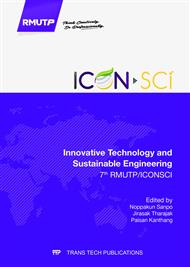[1]
S.A. Aherne, N.M. OʹBrien, Dietary flavonols: chemistry, food content, and metabolism, Nutrition. 18 (2002) 75-81.
DOI: 10.1016/s0899-9007(01)00695-5
Google Scholar
[2]
K. Ishige, D. Schubert, Y. Sagara, Flavonoids protect neuronal cells from oxidative stress by three distinct mechanisms, Free Radic Biol Med. 30 (2001) 433-446.
DOI: 10.1016/s0891-5849(00)00498-6
Google Scholar
[3]
S. Kanthang, K. Sompornpailin, Increasing plant flavonoid biomaterials in response to UV-A light, Adv Mat Res. 802 (2013) 74-78.
DOI: 10.4028/www.scientific.net/amr.802.74
Google Scholar
[4]
P.W. Barnes, M.A. Tobler, K. Keefover-Ring, S.D. Flint, A. E. Barkley, R. J. Ryel, R. L. Lindroth, Rapid modulation of ultraviolet shielding in plants is influenced by solar ultraviolet radiation and linked to alteration in flavonoids, Plant Cell Environ. 39 (2016).
DOI: 10.1111/pce.12609
Google Scholar
[5]
S. Chirumbolo, The role of quercetin, flavonols and flavones in modulating inflammatory cell function, In flamm Allergy Drug Targets. 9 (2010) 263-285.
DOI: 10.2174/187152810793358741
Google Scholar
[6]
K. Rashed, A. Ćirić, J. Glamočlija, M. Soković, Antibacterial and antifungal activities of methanol extract and phenolic compounds from Diospyros virginiana L, Ind Crop Prod. 59 (2014) 210-215.
DOI: 10.1016/j.indcrop.2014.05.021
Google Scholar
[7]
D.A. Okoth, H.Y. Chenia, N.A. Koorbanally, Antibacterial and antioxidant activities of flavonoids from Lannea alata (Engl. ) Engl. (Anacardiaceae), Phytochem Lett. 6 (2013) 476-481.
DOI: 10.1016/j.phytol.2013.06.003
Google Scholar
[8]
R.M. Desentis-Mendoza , H. Hernández-Sánchez , A. Moreno , E.R. del-C, L. Chel-Guerrero, J. Tamariz, M.E. Jaramillo-Flores, Enzymatic polymerization of phenolic compounds using Laccase and Tyrosinase from Ustilago maydis, Biomacromolecules. 7 (2006).
DOI: 10.1021/bm060159p
Google Scholar
[9]
G. Agati, S. Biricolti, L. Guidi, F. Ferrini, A. Fini, M. Tattini, The biosynthesis of flavonoids is enhanced similarity by UV radiation and root zone salinity in L. vulgre leaves, J Plant Physiol. 168 (2011) 204-212.
DOI: 10.1016/j.jplph.2010.07.016
Google Scholar
[10]
T. Murashige, F. Skoog, A revised medium for rapid growth and bioassays with tobacco tissue cultures, Physiol. Plantarum. 15 (1962) 473-497.
DOI: 10.1111/j.1399-3054.1962.tb08052.x
Google Scholar
[11]
J.B. Harborne, Phytochemical Methods: A guide to modern techniques of plant analysis. Chapman and Hall. London. UK. (1998).
Google Scholar
[12]
K. Sompornpailin, S. Kanthang, Tobacco randomly inserted TT8 differenly enhance light signals and flavonoid accumulation, Pak. J. Bot. 47 (2015) 1303-1309.
Google Scholar
[13]
C. Reiss, Experiments in Plant Physiology, New Jersey: Prentice-Hall, (1994).
Google Scholar
[14]
J. Li, T.M. Ou-Lee, R. Raba, R.G. Amundson, R.L. Last, Arabidopsis flavonoid mutants are hypersensitive to UV-B irradiation, Plant Cell. 5 (1993) 171-179.
DOI: 10.1105/tpc.5.2.171
Google Scholar
[15]
B. Winkel-Shirley, Biosynthesis of flavonoids and effects of stress, Plant Biology. 5 (2002) 218-223.
DOI: 10.1016/s1369-5266(02)00256-x
Google Scholar
[16]
M.L.F. Ferreyra, S.P. Rius, P. Casati, Flavonoids: biosynthesis, biological function, and biotechnological applications, Front. Plant Sci. 3 (2012) 1-15.
DOI: 10.3389/fpls.2012.00222
Google Scholar
[17]
E.M. Middleton, A.H. Teramura, The role of flavonol glycosides and carotenoids in protecting soybean from ultraviolet-B damage, Plant Physiol. 103 (1993) 741-752.
DOI: 10.1104/pp.103.3.741
Google Scholar
[18]
L.G. Landry, C.C.S. Chapple, R.L. Last, Arabidopsis mutants lacking phenolic sunscreens exhibit enhanced ultraviolet-B injury and oxidative damage, Plant Physiol. 109 (1995) 1159-1166.
DOI: 10.1104/pp.109.4.1159
Google Scholar
[19]
G. Agati, G. Stefano, S. Biricolti, M. Tattini, Mesophyll distribution of antioxidant flavonoids in Ligustrum vulgare leaves under contrasting sunlight irradiance, Ann. Bot. 104 (2009) 853-861.
DOI: 10.1093/aob/mcp177
Google Scholar
[20]
P.M. Mullineaux, S. Karpinski, Signal transduction in response to excess light: getting out of the chloroplast, Curr Opin Plant Biol. 5 (2002) 43-48.
DOI: 10.1016/s1369-5266(01)00226-6
Google Scholar


